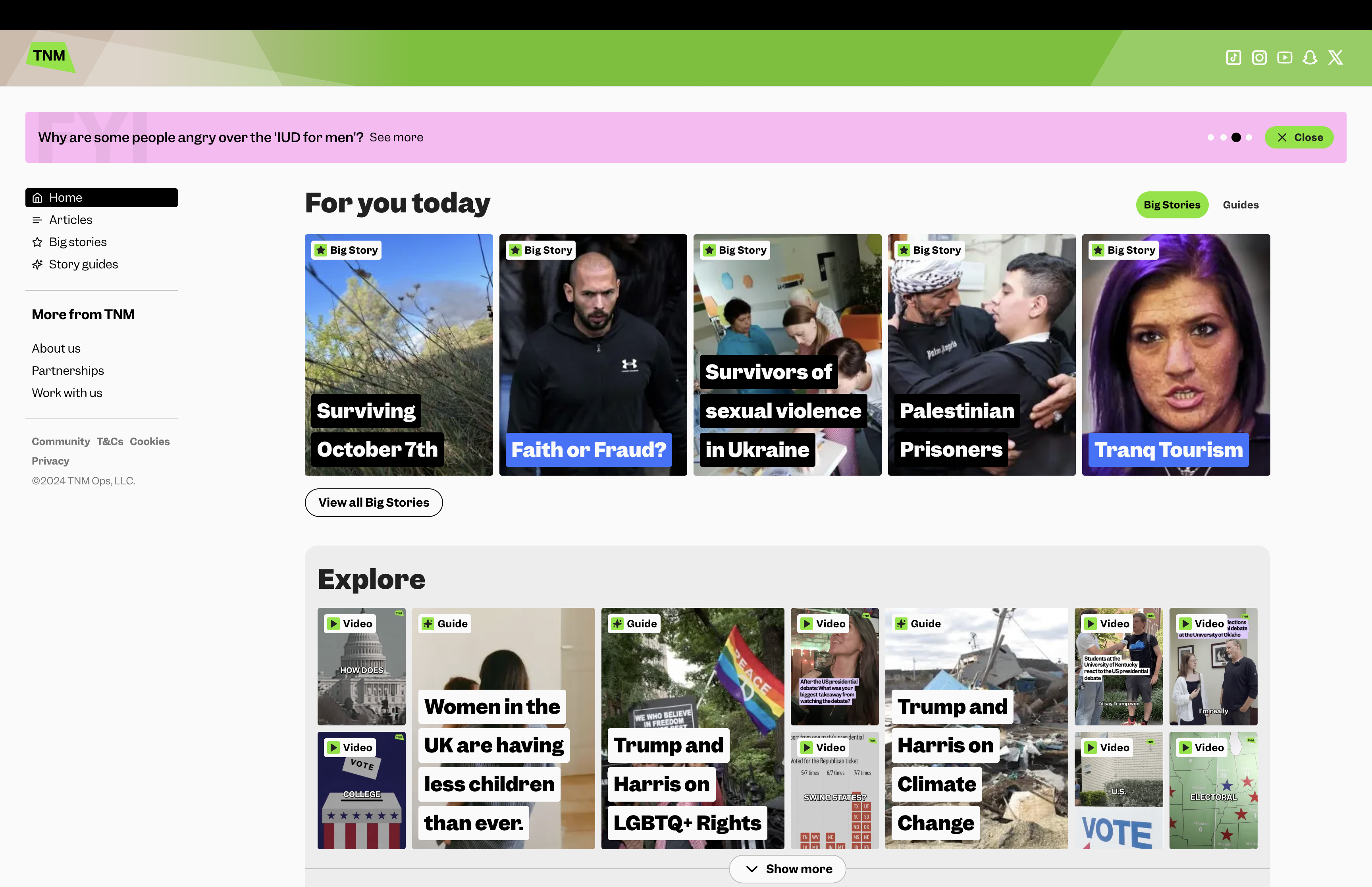Why The News Movement wants to counter ‘temperamental’ social media model

The News Movement has quietly launched a new version of its website as the social-first news startup seeks to build out a more reliable community and business model.
The new-look website provides the ability to watch The News Movement’s videos on the web without the need to access its social accounts.
The homepage features personalised “For You” and “Explore” sections. The site is also populated with written articles by News Movement journalists. Ad inventory is shown on the homepage and in said articles.
Founded in 2021, The News Movement is part of a list of fledgling outlets seeking to address the younger consumer news market, with competitors including the likes of NowThis and, formerly, Vice.

The company produces short- and long-form video news content on platforms like TikTok, Instagram, Snapchat, YouTube. It is particularly popular on TikTok, where its account has racked up 479,000 followers.
It was co-founded by Sir William Lewis, who earlier this year left the startup to become CEO The Washington Post; Eleanor Breen, now chief of staff at the Post; Kamal Ahmed, who this year left to join The Telegraph; current CEO Ramin Beheshti; and chief product and technology officer Dion Bailey.
In an interview with The Media Leader last year, Beheshti communicated that the aim of The News Movement is to reach young people where they are — that is, on social media — and provide them with reliable, accountable news reporting and explainer videos.
However, with the development of The News Movement’s website, the startup is making room for an expanded business and editorial model.
Seeking flexibility and control
The move comes amid a reportedly challenging financial situation for the startup. While The News Movement has raised $15m from investors such as Express publisher National World, this summer The New York Times reported the company has “struggled to wring profits” from its social media followers, and that it projected $9.5m in losses in 2023.
According to the Times, The News Movement sharply reduced its expected revenue from social platforms last year but still missed revenue targets, and it is now in talks to sell a controlling stake to Greek media company Antenna Group, which itself is partially owned by the government of Saudi Arabia.
Other social video newsbrands have similarly struggled in recent years to develop a sustainable business model in an era characterised by fickle algorithmic platform changes. NowThis, formerly a Vox Media property, was spun off in 2023 and less than a year later was forced to lay off half its staff.
Podcast: can you do complex news justice in one minute videos?
In a conversation with The Media Leader, Bailey admitted the move to develop the website occurred in part to address “temperamental” revenue from social platforms.
“It is temperamental, whether its algorithms or [platform] changes or, if you take certain platforms, management issues and situations there,” said Bailey. “Whereas what we’ve seen from a lot of the analysis we have done, to create a main place where people can go, you have a lot more flexibility on want you can do.”
However, Bailey denied the suggestion that developing the website came out of a financially-induced imperative, noting instead that development began on a website strategy during the tail end of last year as a way to better cultivate long-term engagement with the brand.
He described that The News Movement has worked to a “1-9-90” model akin to influencer engagement, aiming to work toward an audience composed of 1% “superfans”, 9% highly engaged, and 90% casually engaged. But through posting on social media alone, Bailey admitted The News Movement might receive many views, but not understand the granularity of its audience; who the actual followers are, whether people are re-engaging, and how strategy should change to develop that audience.
“The website provides a way to have that direct-to-consumer relationship, which I think that, quite frankly, we’ve been we’ve been missing a bit,” he said, adding: “with the social platforms, whilst they’re great in terms of gaining reach, they’re not great in terms of gaining community.”
Developing the audience relationship
 Bailey (pictured, left) admitted The News Movement previously treated the website as “secondary” to its content and business strategy, even as it was increasingly revealing itself to be source of traffic and engagement despite the previous lack of development. He added that focus groups had repeatedly given feedback that they wanted to see more content on the website.
Bailey (pictured, left) admitted The News Movement previously treated the website as “secondary” to its content and business strategy, even as it was increasingly revealing itself to be source of traffic and engagement despite the previous lack of development. He added that focus groups had repeatedly given feedback that they wanted to see more content on the website.
The site, thus, will serve as The News Movement’s “hub” for their most engaged consumers. Bailey revealed the demographic breakdown of site visits is comparable to the startup’s core demographic on social media, something Bailey admitted he was surprised but heartened by.
The News Movement’s young audience is key to its ad sales proposition. While the startup works with marketers on branded content via its in-house content studio, Bailey said the company will also look to develop its advertiser relationships to develop more “dynamic ads” for the site that better align with The News Movement’s content proposition. That could include sponsored takeovers, “especially around [The News Movement’s] lifestyle vertical”, according to Bailey.
Currently, however, The News Movement’s website is only running ads delivered programmatically via a supply-side platform (SSP). Additional potential revenue streams the company is exploring include microtransaction and/or donation-based models. The Recount, a subsidiary newsbrand of The News Movement, has previously explored a “Patreon-like” donation system, which Bailey said has “seen traction”.
8 out of 10 brands’ TikTok videos aren’t working — here’s how to fix it
Like other publishers who have sought greater control over their audiences and intellectual property in recent years, The News Movement is endeavouring to create a space in which the startup can exercise greater control over the two-sided relationship.
“We just weren’t able to leverage that as much as we wanted to on those platforms,” admitted Bailey. “The key thing was really around, how can we create other places for people to interact with us? Rather than think of them as secondary places, can we think of them as just other avenues for them to engage with us? Quite frankly, we can have much more control on that experience [on the site] than any other place.”
Still, social media will continue to play the major role for The News Movement going forward. But rather than being the only way to interact with audiences, the idea now will be to have a “dynamic loop” that directs traffic back and forth between social media and the web.
“You may have millions and millions of views and hundreds of thousands of followers and whatnot, but at the same time are you retaining them?” Bailey asked rhetorically. “Are those sticky? Are you reaching those people?
“Quite frankly, it didn’t feel like we could fully have a handle on that.”
Why parts of the media have a vested interest in intergroup conflict




